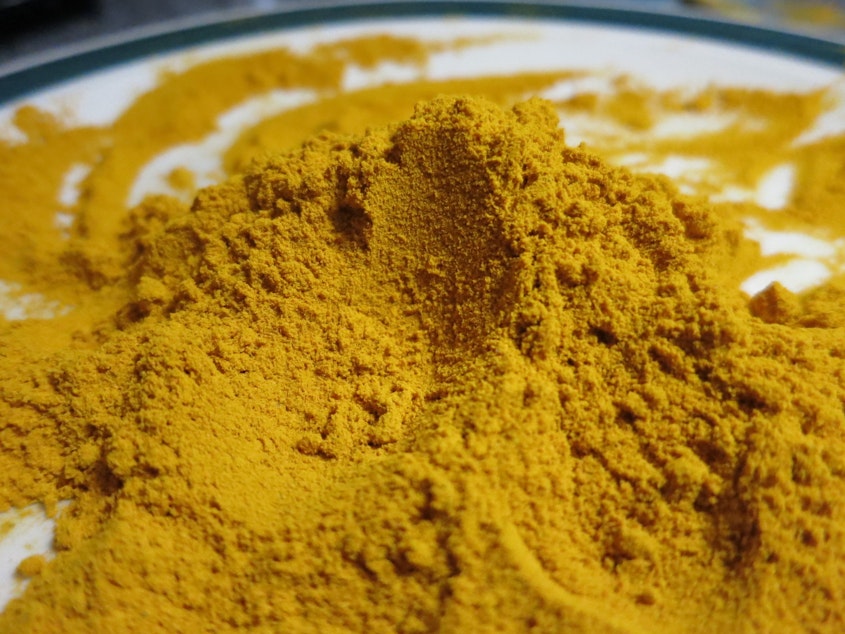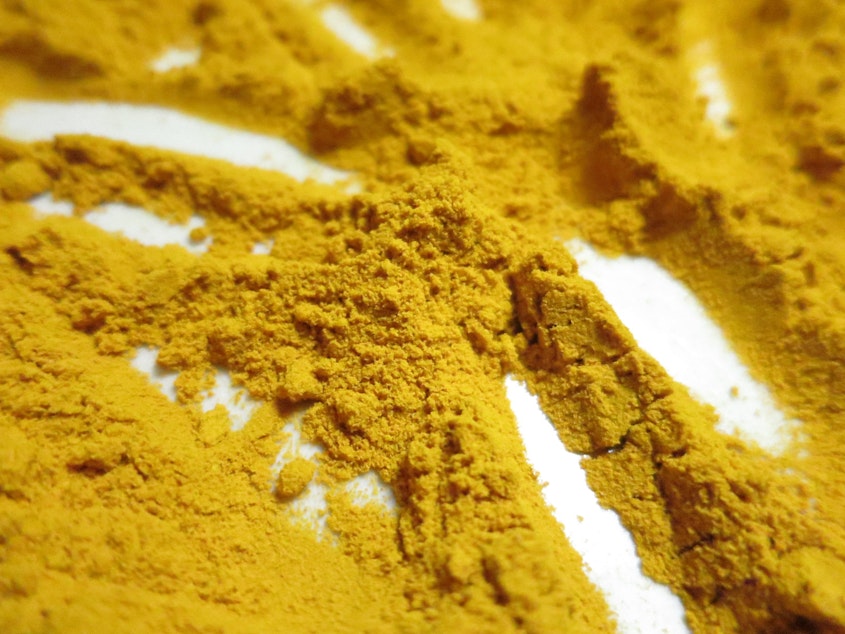Turmeric poisoned their kids. Four Seattle-area cases show gaps in lead testing

Alekhya Gali‘s turmeric came from a trusted store in Bangalore, South India.
“How you add salt, it’s how we add turmeric,” Gali said.
But the spice powder was filled with lead.
Three times more lead than environmental regulators allow in playground soil, in fact.
She had no idea, and the whole family ate it for years.
Kitchen spices are a growing concern when it comes to childhood lead poisoning. Lead exposure damages the brain and other organs, and can hinder a child’s development.
Turmeric has been identified as the source of lead poisoning in at least four Seattle-area families recently. Health professionals worry that many more cases haven’t been identified because of inadequate childhood lead testing in Washington state.
“There are other cases,” said Dr. Jessica Ivers, a Seattle pediatrician at the Polyclinic. “We just need to find them.”
Sponsored
Ivers treated three other children recently who also got lead poisoning from turmeric their parents carried back from India.
The mystery is how the lead is getting into the spices in the first place. Researchers from Stanford and a Dhaka-based institute learned that food processors in Bangladesh regularly enhanced the color of turmeric roots with bright yellow lead chromate to appear higher quality. That research team is planning to study lead-laced turmeric in India this year.
Ivers wants to alert health care providers in the U.S.
“You need to be asking the questions and testing anybody who could potentially be eating home-prepared spices, really anywhere from South Asia,” she said.
The turmeric in the local cases was not the powdered, packaged, supermarket kind.
Sponsored
Gali said her family in India buys the whole turmeric roots from a local store, dries them in the sun at home, and then takes them to a flour mill to be ground into powder. The three other families obtained the spices from their grandparents in the Indian states of Uttar Pradesh, Madhya Pradesh, and Andhra Pradesh.
Spices at American grocery stores can also contain heavy metals – including lead. Last year Consumer Reports tested over a hundred products and found concerning levels of metals in turmeric, basil, cumin and more.
New York City’s health department tested nearly 1,500 samples of spices between 2008 and 2017. The agency found detectable levels of lead in nearly half the samples of turmeric purchased in the United States, and in more than 50% of spices overall.
Researchers in Boston did a similar study in 2011 and 2012 and found lead in all 32 samples of turmeric purchased in local stores. A North Carolina study also found troubling levels of lead in spices consumed by children.
Concerned about lead poisoning and turmeric? Scroll to the bottom of this story.
Sponsored
“We're not actually doing our job with testing enough kids,” said Dr. Amish Dave, who educates doctors on lead testing with the King County Medical Society and Indian American Community Services.
Up to 98% of children in Washington state with lead poisoning are never identified, according to estimates from one study published in the journal, Pediatrics.
“When we do find the cases, they tend to be the most egregious cases with kids with extremely high levels of blood lead,” Dave said.
A tiny fraction of children are tested for lead in King County and Washington state, according to data from the state Department of Health. In 2019, around 5% of children under the age of 6 got tested. In 2020, that dropped to below 4%.
That’s one of the lowest testing rates in the nation, according to the CDC.
Sponsored
Moreover, even though federal law mandates that children on Medicaid be tested in their first two years of life, over 100,000 toddlers a year who are eligible in Washington don’t get tested, according to the data from the state Health Care Authority, which manages the program.
That’s upwards of 85% of toddlers on Medicaid who are considered high risk for lead poisoning but aren’t getting checked.
Many things explain that gap, said Dr. Charissa Fotinos, acting Medicaid director. Health care providers make the ultimate decision whether to test a child, and some doctors disagree that it’s clinically necessary or worth it to test, she said.
“At the end of the day, we can’t make them do anything,” she said.
At most clinics, you have to draw blood from a baby’s vein for a blood test – try doing that on a wiggling, screaming, scared 1-year-old whose parents are equally stressed out. Fotinos said she has done that as a family doctor, and it’s not easy.
Sponsored
Plus, some doctors were trained that lead poisoning is not a local problem. Even Dr. William Robertson, founder of Washington Poison Center, discouraged it when he trained residents decades ago, said Fotinos, who trained with him.
Back in 1998, Robertson wrote to a medical journal saying he was disappointed that their list of "What's no longer worth doing?" did not include universal lead testing and counseling families about lead, unless they were at high risk.
“He was sort of the local authority on poisoning and children and was very clear that lead poisoning was a non-issue here,” Fotinos said. “So generations, at least back 30 years, of pediatricians and all of us family doctors who rotated through Seattle Children's heard that message.”
Dave said another misconception is that lead paint isn’t a problem in Washington state because we have younger housing stock. In reality, around half of King County homes were built before the U.S. banned lead-based paint in the late 1970s, according to Census data.
Lead is insidious and can show up in unexpected places, from traditional remedies and cosmetics to toys, cookware, and jewelry – even sparkly cake-decorations and the fuel burned by some of our beloved local seaplanes.
A few things could help find the kids with lead poisoning, Dave said. First, the state should fund more rapid lead testing machines at clinics, which require just the prick of a finger, he said. (Though many machines are currently under a recall.)
Doctors could also provide patients with questionnaires on their risk of lead exposure, such as the age of their housing, Dave said, which would save time in the exam room.
As for federal oversight, the FDA has not created limits for the amount lead allowed in spices, though it has for candy, juice, ceramics and silverware. But it has banned some overseas companies from importing turmeric and other spices because of lead contamination.

Testing at his pediatrician’s office in California is what originally caught the high lead levels in the blood of Risheek Arjun, Alekhya Gali’s son.
Last year the family relocated to Lynnwood and he got tested again. His levels were still high and public health workers got involved.
They came to the house and zapped food samples with a special X-ray gun to examine their content. That’s when the family finally learned that their turmeric was filled with lead.
“We didn’t know what to say,” Gali said.
The shock was especially deep because turmeric is so culturally and medicinally important. Mixed with warm water or milk it’s their “go-to” remedy for cold and flu season, Gali said.
“Turmeric is from the ancient ages,” she said.
But their contaminated turmeric powder went straight in the trash.
Gali even stopped cooking with any turmeric for a while, producing colorless curries that she found unsettling.
“Imagine yourself eating a purple burger, or an orange burger, or a colorless burger,” Gali said.
Today Risheek Arjun is doing well and is a happy boy who loves to be cuddled. His speech is delayed, however, and he is picky about food, which are possible consequences of lead exposure.
The baby’s blood lead level has gone down, and now he’s in speech therapy. The family is back to eating turmeric, but only from U.S. companies, on the advice of public health.
If you’re concerned about lead poisoning and your turmeric:
Dr. Jessica Ivers says there aren’t many signs and symptoms of lead poisoning, but children with developmental delays should get tested – for example, if the child is a late talker, isn’t feeding well, or is behind on other milestones.
If the child is anemic, that should also prompt a lead test, Dr. Amish Dave said. Lead testing can be done at the pediatrician’s office or a lab.
As for testing turmeric itself, home testing kits like 3M’s Lead Check are not effective, said Jenna Forsyth, a researcher at Stanford who studies lead contamination in turmeric in Bangladesh and India.
The test kits change color when exposed to lead, but the compound in turmeric that causes its yellow color, curcumin, interferes with the results, she said.
Forsyth tests her turmeric samples at the Stanford lab or a lab in the Eurofins network. The Eurofins Nutritional Analysis Center in Des Moines, Iowa can test for lead in turmeric for around $75.
In Seattle, NVL Labs charges $105.60 with a one-day turnaround or $57 for a one-week turnaround.
Clarification 1/26/2022: This article has been updated to clarify that Dr. William Robertson trained residents decades ago. It has also been updated to state the study in Pediatrics estimated 98% of children with elevated blood levels in Washington state were not found.




